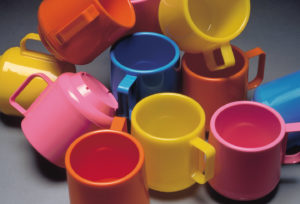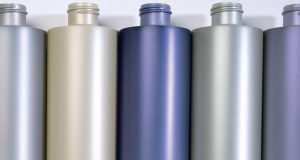Home » Colouration Methods
Colouration Methods
This section is aimed at the plastics processor
When selecting a method of colouration the processor should assess the alternatives available and decide which is the most suitable for his particular circumstances. No single method of colouration is ideal for all applications.
To assist comparison all of the colouring methods in the section are evaluated under the following headings:
- Quality: The pigment dispersion must satisfy aesthetic requirements and colouration must not impair the physical properties of the plastic article.
- Technology necessary: If the colouring process cannot be carried out with existing staff and equipment, the advantages gained from its implementation should offset the initial cost.
- Environmental hazards: Some systems are messy for the operator and contribute to in-plant pollution and cross contamination.
- Versatility: If the method is versatile, the moulder can quickly and easily respond to his customers’ demands.
- Cost: The cost of producing an article is related to cost for raw materials, labour, equipment downtime, operator error etc.
- Other factors: Colouration methods often have specific advantages and disadvantages.
Fully Coloured Resin
If very large runs are involved, colour can be added at the primary extrusion stage when the reactor powder is being converted to granules. It is far more common to re-extrude natural granules together with colourants. Thus compound usually commands a significant surcharge over uncoloured resin, so it is mostly used where other colouring methods are not suitable e.g. rotational moulding. Where the natural polymer needs to be compounded anyway e.g. talc-filled PP, the compound is generally coloured at the same time.
- Quality: This method provides a quality standard by which other colouring methods are judged.
- Technology necessary:
- Environmental hazards:
- Versatility: Not versatile – limited choice of stock colours, slow delivery of custom colours, large minimum runs.
- Cost: Usually the raw material cost is higher than with alternative methods.
- Other factors: None.
In-plant colouring
In-plant colouring, where the plastics processor adds the colourant to natural polymer, is on the whole the most economical and versatile method of colouring thermoplastics. Money and space are not tied up in keeping large stocks of various coloured compounds – only natural polymer needs to be stocked.
Suitably colour matched preparations may be supplied in the form of dry colour, masterbatch or liquid colour. Dry colour is almost never used in Australia any more – it is only included here for the sake of completion. Whichever type of preparation is chosen, the processor may blend the colourant with natural polymer and transport the mix to the machine, or add colourant at the machine using an automatic dispenser.
Dry colour
Colourants pre-blended to a specific shade, usually incorporating extenders and dispersion aids. Dry colour is usually mixed with plastic granules in a slow speed blender e.g. tumble mixer, and the mixture transported to the moulding machine. Using disposable plastic drum liners will reduce clean down times. Adding a small amount of a wetting agent such as paraffin oil, epoxidized soya bean oil, etc. when tumble mixing, will eliminate dusting and improve dispersion.
- Quality: Colour dispersion is not sufficient for thin gauge applications such as blown film; but uniform, high quality colourations can be obtained in thick section articles.
- Technology necessary: A tumble mixer, which can service several machines.
- Environmental hazards: Messy for the operator and can contribute to dusting and cross-contamination.
- Versatility: Very versatile – small minimum quantities and the same dry colour may be used for several polymers.
- Cost: Similar to other in-plant colouring methods.
- Other factors: Labour intensive and subject to operator error.
Thermoplastic masterbatch
These materials contain high pigment loadings, typically 20% to 80%, pre-dispersed in specific thermoplastic resins.
Normal usage rates are 1% to 5% by weight of natural resin. Masterbatches are usually supplied as granules. For critical applications it is usual to use a masterbatches based on a similar resin to the one being processed. “Universal” or “multipurpose” masterbatches compatible with a number of thermoplastics are available. They have the advantage of reducing the quantity of colourant stocks.
- Quality: The pigment is pre-dispersed so shade variations, specs and streaks are largely eliminated. Insufficient mixing of masterbatch granules with natural polymer during processing will result in swirls of different colour density in the moulding. Separation of masterbatch granules in the machine hopper will result opacity variations from one article to another
- Technology necessary: Masterbatch can be mixed with plastic using a tumble mixer. Time and labour savings will be increased, and colour consistency improved, by automatic metering, preferably directly onto the machine screw. Gravimetric feeders are more suitable than volumetric feeders.
- Environmental hazards:
- Versatility: With a number of competing suppliers offering a wide range of multi-purpose masterbatches, fast colour matching and delivery for custom colours; masterbatching has become a very versatile method of colouration.
- Cost: Masterbatch is by far the most popular methods of colouring thermoplastics. Large volume runs, high colour yields due to optimum dispersion and competition between suppliers, all have tended to reduce the cost of masterbatch. Thus masterbatch often turns out to be the most cost-effective colouring method, especially if combined with automatic metering.
- Other factors: Masterbatches permit very high pigment loadings and being pre-dispersed are suitable for thin walled applications like blown film.
Liquid colour
Here the colourants are dispersed in a liquid vehicle. Non-reactive, high boiling point liquids are used, which form an integral part of the polymer matrix when processed. Pigment loadings are usually between 20% and 65% and typical usage is 0.1% to 2% by weight of natural polymer. Pigment loadings are restricted by the need to retain a pumpable viscosity. Liquid colour is usually metered directly onto the screw, using an automatic metering pump activated by the screw back cycle. Diaphragm, piston and peristaltic pumps are available. The peristaltic pump has proven to be the most popular – least clean-up required during colour changes.
- Quality: Plastic granules are evenly coated with the pre-dispersed paste resulting in high quality colourations even at very low addition rates e.g. 0.05%. High addition rates should be avoided because the carrier can cause screw slippage, surface blushing and a loss of properties.
- Technology necessary: Liquid colour is best metered onto the machine screw using a liquid colour pump. May need to be re-mixed after prolonged storage due to a tendency to settle.
- Environmental hazards: Spills can be messy.
- Versatility: Versatile in the areas where it is suitable e.g. tints, transparent and translucent colours, which require a low addition rate.
- Cost: Generally the cost/kg is higher than masterbatch. In certain areas, low addition rates and lack of haze in transparent colours can more than offset this.
- Other factors: Ideal for incorporating liquid or heat-sensitive additives e.g. liquid stabilizers, blowing agents, etc.
In-plant colouring using basic pigments
The method involves using pigments and dyes as supplied by their manufacturers. It is sometimes used when processing PVC powder e.g. pipe and profile extrusion. This colouring method is the cheapest and most versatile type of in-plant colouring, but is not practical for most plastic converters.
Improving quality of in-house coloured articles
In general best dispersion and also the most uniform melt quality is obtained when a large percentage of the energy input is supplied mechanically. When injection moulding this can be done by lowering barrel temperatures and increasing the back-pressure and screw speed to generate extra heat mechanically. Special compounding screws that help to homogenize the melt are available for most machines.
Problems encountered with mixing the colour uniformly throughout the plastics e.g. with masterbatch used at very low addition rates, can be solved by fitting a mixing nozzle to an injection moulding machine or a melt blender to an extruder.
A final word for now...
I have discussed the colorants which possess a balance of properties that makes them suitable for plastics. The choice in any individual situation is made from the total range available, both organic and inorganic, usually combining the two types.
Having settled on a particular matching, there are then several different colouring methods available and no single one is ideal for all applications.
When planning to manufacture a coloured article, the plastics processor would normally consult his suppliers and consider the available alternatives. The colouring method which achieves the required quality standard most efficiently and at the lowest overall cost is then selected.
© Vibron 2018




